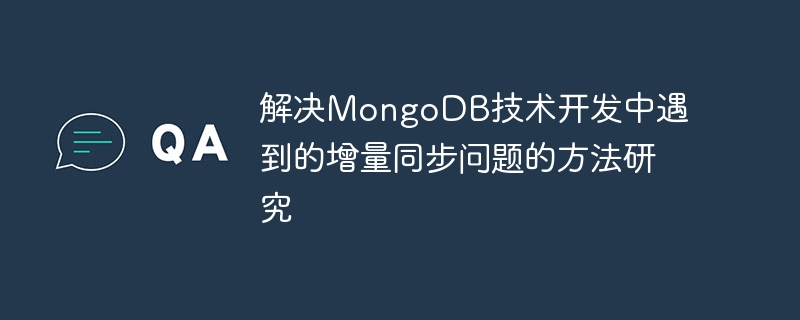
Research on methods to solve incremental synchronization problems encountered in MongoDB technology development
Abstract:
With the increase in data volume and business needs With the changes, we often encounter the problem of incremental synchronization in MongoDB technology development. This article will introduce a method to solve the MongoDB incremental synchronization problem and provide specific code examples.
MongoDB is a non-relational database with high performance and scalability. However, in practical applications, we often need to synchronize data in MongoDB to other systems or databases to meet business needs. Incremental synchronization refers to synchronizing only updated data, rather than fully synchronizing all data. This article will introduce an incremental synchronization method based on MongoDB.
The principle of incremental synchronization method is to record the timestamp of each synchronization operation, and then synchronize the updated data according to the timestamp . The specific steps are as follows:
Step 1: Create a collection in MongoDB that records synchronization timestamps (such as sync_info).
Step 2: Add a field (such as sync_timestamp) to the collection that needs to be synchronized to store the update time of the data.
Step 3: Each time a data operation (such as insert, update, delete) is performed, the synchronization timestamp field is updated at the same time.
Step 4: Query the sync_info collection regularly to obtain the timestamp of the last synchronization.
Step 5: Query the data that needs to be synchronized based on the timestamp of the last synchronization, and perform the synchronization operation.
The following is a sample code that uses Python and the pymongo library to implement incremental synchronization:
import pymongo
# 配置MongoDB连接
client = pymongo.MongoClient('mongodb://localhost:27017/')
db = client['test_db']
# 获取同步时间戳
def get_last_sync_timestamp():
sync_info = db['sync_info']
timestamp = sync_info.find_one()['timestamp']
return timestamp
# 更新同步时间戳
def update_sync_timestamp(timestamp):
sync_info = db['sync_info']
sync_info.update_one({}, {'$set': {'timestamp': timestamp}}, upsert=True)
# 同步数据
def sync_data(last_sync_timestamp):
collection = db['collection_name']
query = {'sync_timestamp': {'$gt': last_sync_timestamp}}
data = collection.find(query)
# 进行数据同步操作
for doc in data:
# TODO: 执行同步操作
# 更新同步时间戳
update_sync_timestamp(timestamp)
if __name__ == '__main__':
last_sync_timestamp = get_last_sync_timestamp()
sync_data(last_sync_timestamp)In the above code, we MongoDB's pymongo library is used to connect to the MongoDB database. First, we get the timestamp of the last synchronization through the get_last_sync_timestamp function. Then, we use the sync_data function to query data greater than the last synchronization timestamp and perform synchronization operations. Finally, we update the synchronization timestamp using the update_sync_timestamp function.
This article introduces a method to solve the MongoDB incremental synchronization problem and provides specific code examples. By recording synchronization timestamps and performing incremental synchronization based on the timestamps, we can reduce unnecessary data transmission and improve synchronization efficiency. Using the above method, you can easily implement MongoDB incremental synchronization to meet business needs.
The above is the detailed content of Research on methods to solve incremental synchronization problems encountered in MongoDB technology development. For more information, please follow other related articles on the PHP Chinese website!
 The difference between mongodb and mysql
The difference between mongodb and mysql
 mongodb startup command
mongodb startup command
 How to delete data in MongoDB
How to delete data in MongoDB
 Commonly used database software
Commonly used database software
 What are the application areas of mongodb?
What are the application areas of mongodb?
 Which one has faster reading speed, mongodb or redis?
Which one has faster reading speed, mongodb or redis?
 How to completely delete mongodb if the installation fails
How to completely delete mongodb if the installation fails
 Mongodb and mysql are easy to use and recommended
Mongodb and mysql are easy to use and recommended




